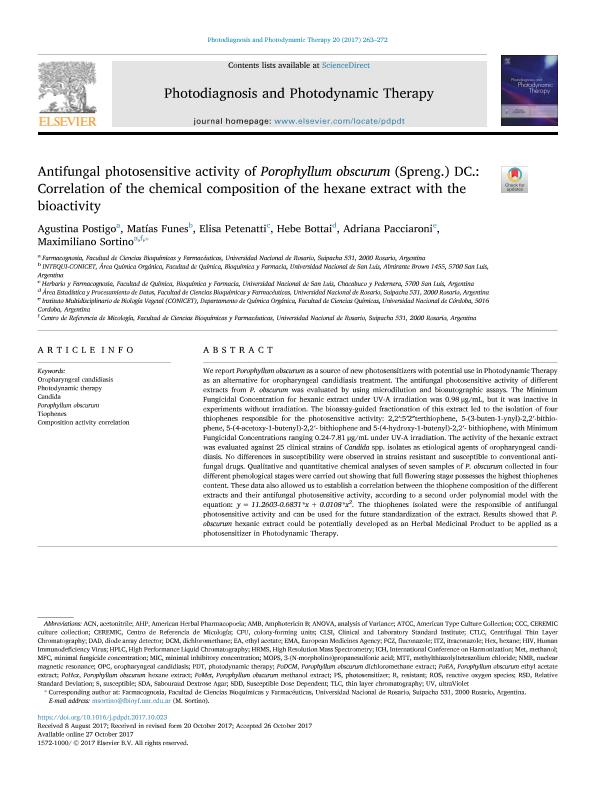Mostrar el registro sencillo del ítem
dc.contributor.author
Postigo, Agustina

dc.contributor.author
Funes, Matías Daniel

dc.contributor.author
Petenatti, Elisa Margarita

dc.contributor.author
Bottai, Hebe
dc.contributor.author
Pacciaroni, Adriana del Valle

dc.contributor.author
Sortino, Maximiliano Andrés

dc.date.available
2018-11-14T14:38:35Z
dc.date.issued
2017-12
dc.identifier.citation
Postigo, Agustina; Funes, Matías Daniel; Petenatti, Elisa Margarita; Bottai, Hebe; Pacciaroni, Adriana del Valle; et al.; Antifungal photosensitive activity of Porophyllum obscurum (Spreng.) DC.: Correlation of the chemical composition of the hexane extract with the bioactivity; Elsevier Science; Photodiagnosis Photodynamic Therapy; 20; 12-2017; 263-272
dc.identifier.issn
1572-1000
dc.identifier.uri
http://hdl.handle.net/11336/64454
dc.description.abstract
We report Porophyllum obscurum as a source of new photosensitizers with potential use in Photodynamic Therapy as an alternative for oropharyngeal candidiasis treatment. The antifungal photosensitive activity of different extracts from P. obscurum was evaluated by using microdilution and bioautographic assays. The Minimum Fungicidal Concentration for hexanic extract under UV-A irradiation was 0.98 μg/mL, but it was inactive in experiments without irradiation. The bioassay-guided fractionation of this extract led to the isolation of four thiophenes responsible for the photosensitive activity: 2,2′:5′2″terthiophene, 5-(3-buten-1-ynyl)-2,2′-bithiophene, 5-(4-acetoxy-1-butenyl)-2,2′- bithiophene and 5-(4-hydroxy-1-butenyl)-2,2′- bithiophene, with Minimum Fungicidal Concentrations ranging 0.24-7.81 μg/mL under UV-A irradiation. The activity of the hexanic extract was evaluated against 25 clinical strains of Candida spp. isolates as etiological agents of oropharyngeal candidiasis. No differences in susceptibility were observed in strains resistant and susceptible to conventional antifungal drugs. Qualitative and quantitative chemical analyses of seven samples of P. obscurum collected in four different phenological stages were carried out showing that full flowering stage possesses the highest thiophenes content. These data also allowed us to establish a correlation between the thiophene composition of the different extracts and their antifungal photosensitive activity, according to a second order polynomial model with the equation: y = 11.2603-0.6831*x + 0.0108*x2. The thiophenes isolated were the responsible of antifungal photosensitive activity and can be used for the future standardization of the extract. Results showed that P. obscurum hexanic extract could be potentially developed as an Herbal Medicinal Product to be applied as a photosensitizer in Photodynamic Therapy.
dc.format
application/pdf
dc.language.iso
eng
dc.publisher
Elsevier Science

dc.rights
info:eu-repo/semantics/openAccess
dc.rights.uri
https://creativecommons.org/licenses/by-nc-sa/2.5/ar/
dc.subject
Candida
dc.subject
Composition Activity Correlation
dc.subject
Oropharyngeal Candidiasis
dc.subject
Photodynamic Therapy
dc.subject
Porophyllum Obscurum
dc.subject
Tiophenes
dc.subject.classification
Otras Ciencias Biológicas

dc.subject.classification
Ciencias Biológicas

dc.subject.classification
CIENCIAS NATURALES Y EXACTAS

dc.title
Antifungal photosensitive activity of Porophyllum obscurum (Spreng.) DC.: Correlation of the chemical composition of the hexane extract with the bioactivity
dc.type
info:eu-repo/semantics/article
dc.type
info:ar-repo/semantics/artículo
dc.type
info:eu-repo/semantics/publishedVersion
dc.date.updated
2018-10-23T17:42:24Z
dc.journal.volume
20
dc.journal.pagination
263-272
dc.journal.pais
Países Bajos

dc.journal.ciudad
Amsterdam
dc.description.fil
Fil: Postigo, Agustina. Consejo Nacional de Investigaciones Científicas y Técnicas. Centro Científico Tecnológico Conicet - Rosario; Argentina. Universidad Nacional de Rosario. Facultad de Ciencias Bioquímicas y Farmacéuticas. Departamento de Química Orgánica. Área Farmacognosia; Argentina
dc.description.fil
Fil: Funes, Matías Daniel. Consejo Nacional de Investigaciones Científicas y Técnicas. Centro Científico Tecnológico Conicet - San Luis. Instituto de Investigaciones en Tecnología Química. Universidad Nacional de San Luis. Facultad de Química, Bioquímica y Farmacia. Instituto de Investigaciones en Tecnología Química; Argentina
dc.description.fil
Fil: Petenatti, Elisa Margarita. Universidad Nacional de San Luis. Facultad de Química, Bioquímica y Farmacia; Argentina
dc.description.fil
Fil: Bottai, Hebe. Universidad Nacional de San Luis. Facultad de Química, Bioquímica y Farmacia; Argentina
dc.description.fil
Fil: Pacciaroni, Adriana del Valle. Consejo Nacional de Investigaciones Científicas y Técnicas. Centro Científico Tecnológico Conicet - Córdoba. Instituto Multidisciplinario de Biología Vegetal. Universidad Nacional de Córdoba. Facultad de Ciencias Exactas Físicas y Naturales. Instituto Multidisciplinario de Biología Vegetal; Argentina
dc.description.fil
Fil: Sortino, Maximiliano Andrés. Consejo Nacional de Investigaciones Científicas y Técnicas. Centro Científico Tecnológico Conicet - Rosario; Argentina. Universidad Nacional de San Luis. Facultad de Química, Bioquímica y Farmacia; Argentina. Universidad Nacional de Rosario. Facultad de Ciencias Bioquímicas y Farmacéuticas. Departamento de Química Orgánica. Área Farmacognosia; Argentina
dc.journal.title
Photodiagnosis Photodynamic Therapy

dc.relation.alternativeid
info:eu-repo/semantics/altIdentifier/doi/https://doi.org/10.1016/j.pdpdt.2017.10.023
dc.relation.alternativeid
info:eu-repo/semantics/altIdentifier/url/https://www.sciencedirect.com/science/article/pii/S157210001730368X
Archivos asociados
